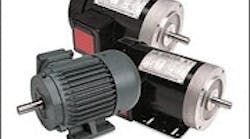The basic physics and mechanical principles of motors seem to remain eternally constant. Conversely, motor sizes, types, components, capabilities, magnetic materials and applications diversify rapidly in response to shifting user demands. Likewise, more sophisticated motion technologies intrude on applications usually served by workhorse motors, but some traditional motors ironically are being refined for nontraditional applications, too.
There are at least two powerful forces pushing machine builders and other users to demand these new and more varied motor functions—skyrocketing energy costs and low-cost competition from machine builders in developing regions, particularly in China and elsewhere in Asia. In addition, while some users look into energy-efficient motors because of potential savings and competitive differentiation, others realize that NEMA premium-efficiency levels for 100-200 hp motors will be required by the U.S. Department of Energy's (DoE) Energy Independence and Security Act (EISA) that goes into effect in December 2010.This new requirement might expand to include 1-500 hp in the future.
"We've been building premium-efficiency motors for 20-25 years, and even now conventional induction motors might be able to pick up another 2-6% in efficiency," says John Malinoswski, senior product manager for ac motors at Baldor (www.baldor.com). "But we're nearing the physical maximum efficiency available with existing materials and techniques. So, instead of just replacing components for a small bump in efficiency, much bigger gains can be made by looking at the whole system in which a motor is used, and adding variable-speed drives (VSDs) to better control the output of pumps, fans, compressors and other equipment. There's no sense in putting a 96% efficient motor on a 50% efficient pump, so everyone is beginning to do a better job of figuring out the right pump or device for the application. For instance, using an efficient, correctly sized compressor with a VSD and an efficient motor can have a payback in just six months. Energy always was someone else's problem. Now we can save it by looking at whole systems from everything we're driving on back to the power line."
Likewise, many users are looking more closely at servo motor technologies with permanent magnets, which are initially more costly but can produce more power in a smaller space due to their greater magnetic density. Besides the ongoing emergence of switched-reluctance and permanent-magnet motors, SEW-Eurodrive (www.seweurodrive.com) reports its cast-copper-rotor motors enable more accurate positioning, tighter control and higher torques at lower speeds. "Three-phase induction motors are about as efficient as they can be, and so we need new technologies such as permanent magnets, variable-frequency drives (VFDs) and mechatronics," says Tim Schumann, SEW-Eurodrive's corporate engineer. "The core problem with premium motors is that they're made from more engineered substances, and the cost of those raw materials is going up because there's a global shortage of rotor and stator steel and other materials."
In addition, Ralph Baran, motors product manager in Siemens Industry's (www.usa.siemens.com/industry) motion control division, explains that general-purpose motors and more-coordinated motion control devices once functioned separately and used different drive systems, but the two camps have started to blend their technologies and markets in recent years. "A typical plastic extruder used to have a general induction motor but would use a more sophisticated motor for winding, cutting and motion synchronization," says Baran. "Now, we're learning to run standard and high-end motion on one drive, but we're also about to introduce a new induction motor family that's optimized for high-performance motion by using higher-resolution encoders and VSDs. These are similar to spindle motors used in machine tooling, but other industries have observed these capabilities, and they want them for their applications. For instance, some injection mold companies are transitioning to direct-drive motors to help differentiate them from their Chinese competitors. When folks in the paper industry saw this, they wanted direct drives, too. They might only save a few milliseconds per cycle, but this can add up to an extra 500 parts per day."




